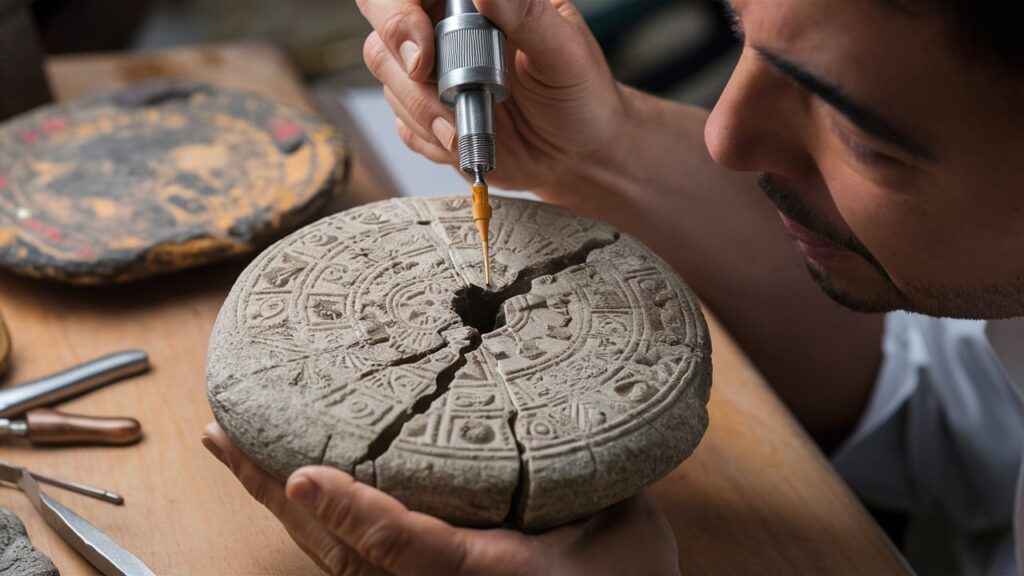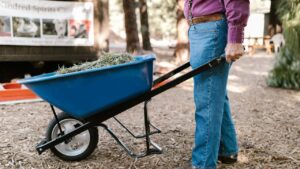Fixing broken stone items can be tricky. The right glue is essential.
Whether you’re mending a cherished stone sculpture or repairing a cracked countertop, choosing the correct adhesive is crucial. This guide will walk you through the different types of glues suitable for stone repairs. You will learn how to select the best one based on your specific needs.
From understanding glue types to application tips, we’ve got it all covered. By the end, you’ll feel confident in fixing stone items effectively. Let’s dive into the world of stone adhesives and make sure your repairs are strong and lasting.
Types Of Stone Glue
Choosing the right glue for stone repairs can be a challenge. Different types of stone glue have unique properties. Each type serves a specific purpose and works best for certain types of stone. In this section, we will explore three common types of stone glue.
Epoxy Resin
Epoxy resin is known for its strong bonding properties. It is a two-part adhesive that needs mixing before use. Epoxy resin works well on granite, marble, and other heavy stones. It provides a durable bond, making it ideal for structural repairs. This glue also resists water and chemicals. It is perfect for outdoor stone repairs.
Polyurethane Adhesive
Polyurethane adhesive is versatile and easy to use. It is a one-part adhesive that cures with moisture. This glue works on a variety of stones, including limestone and sandstone. Polyurethane adhesive is flexible, making it suitable for stones that expand and contract. It also provides a strong bond and is resistant to weather conditions.
Cyanoacrylate
Cyanoacrylate, also known as super glue, is great for small stone repairs. It bonds quickly and dries fast. This glue works best on small, non-porous stones. Cyanoacrylate is not ideal for heavy stones or structural repairs. It is perfect for fixing minor chips and cracks. This glue is also transparent, which helps maintain the stone’s appearance.

Factors To Consider
Choosing the right glue for stone repairs is crucial. It ensures durability and longevity. Several factors influence the choice of adhesive. This guide covers the most important ones.
Type Of Stone
The type of stone affects your choice of glue. Different stones have unique properties. For instance, granite is hard and dense. Marble, on the other hand, is softer and more porous.
Here is a simple table for reference:
| Stone Type | Characteristics | Recommended Glue |
|---|---|---|
| Granite | Hard, Dense | Epoxy Resin |
| Marble | Soft, Porous | Polyester Resin |
| Limestone | Soft, Porous | Polyurethane |
Location Of Repair
Where the repair is located matters. Indoor repairs may need different adhesives than outdoor ones. For indoor repairs, you can use standard glues. Outdoor repairs need weather-resistant adhesives.
- Indoor Repairs: Standard glues like epoxy or cyanoacrylate.
- Outdoor Repairs: Weather-resistant adhesives like polyurethane.
Environmental Conditions
Environmental conditions also play a significant role. Factors like temperature and humidity affect the glue’s performance.
Consider the following:
- Temperature: High temperatures can weaken some adhesives.
- Humidity: Moist environments require waterproof glues.
Ensure you choose an adhesive that can withstand the local climate.
Preparing The Surface
Preparing the surface is the first step in any stone repair project. Proper preparation ensures the glue adheres well and the repair lasts. Let’s explore the steps involved in preparing the stone surface for repair.
Cleaning The Stone
Begin by cleaning the stone thoroughly. Dirt, dust, and grease can prevent the glue from sticking properly. Use a soft brush to remove loose particles. Then, wash the stone with a mild detergent and water. Rinse well and ensure all soap residues are gone.
Drying The Surface
After cleaning, the stone surface must be completely dry. Any moisture can weaken the bond. Use a clean, dry cloth to wipe the stone. Let it air dry for at least 24 hours. In humid conditions, use a fan or a dehumidifier to speed up the drying process.
Sanding For Adhesion
Sanding the stone surface creates a rough texture. This improves the glue’s adhesion. Use fine-grit sandpaper to sand the area where the glue will be applied. Sand in a circular motion to ensure even roughness. After sanding, wipe the surface with a damp cloth to remove dust, and let it dry again.
Application Techniques
Choosing the right glue for stone repairs is only the first step. Proper application techniques ensure a strong and lasting bond. This section covers essential methods for mixing, applying, clamping, and curing the adhesive.
Mixing The Adhesive
Before applying the adhesive, mix it thoroughly. Follow the instructions on the package. Most adhesives require a precise ratio of resin and hardener. Use a clean, disposable container for mixing.
- Measure the components accurately.
- Stir the mixture with a wooden stick.
- Mix until you achieve a uniform color.
Applying Evenly
Even application prevents weak spots. Use a small brush or spatula to spread the adhesive. Apply a thin, consistent layer on both surfaces.
- Clean the stone surfaces first.
- Apply adhesive to one surface.
- Press the pieces together firmly.
Check for air bubbles and remove them. An even layer ensures a strong bond.
Clamping And Curing
Clamping is crucial for a tight bond. Use clamps to hold the stones together. Ensure they are aligned perfectly.
| Type of Clamp | Usage |
|---|---|
| Spring Clamp | Small repairs |
| Bar Clamp | Large repairs |
Let the adhesive cure fully. Curing times vary by product. Check the manufacturer’s instructions. Avoid moving the stones during this period.
Safety Precautions
When working on stone repairs, ensuring your safety is crucial. This section outlines essential safety precautions to follow. Proper safety measures protect you from potential hazards and ensure a smooth repair process.
Protective Gear
Wearing the right protective gear is essential for any stone repair project. Here’s a list of basic protective equipment you should use:
- Safety goggles: Protect your eyes from debris and dust.
- Gloves: Shield your hands from chemicals and sharp edges.
- Dust mask: Prevent inhalation of harmful particles.
- Long-sleeved clothing: Cover your skin from splashes and cuts.
Ensure all gear fits properly and is in good condition.
Ventilation
Proper ventilation is vital when using adhesives and chemicals. Many glues release fumes that can be harmful if inhaled. Follow these tips to maintain good ventilation:
- Work in a well-ventilated area, such as outdoors or near open windows.
- Use fans to circulate air and reduce fume concentration.
- Avoid working in confined spaces without proper airflow.
Good ventilation helps protect your respiratory system from toxic fumes.
Handling Chemicals
When handling chemicals, care and caution are paramount. Follow these guidelines for safe chemical handling:
- Read and follow the manufacturer’s instructions carefully.
- Store chemicals in a cool, dry place away from children and pets.
- Never mix different chemicals unless specified by the manufacturer.
- Dispose of chemical waste according to local regulations.
- Wash your hands thoroughly after handling any chemicals.
By following these precautions, you can minimize risks and ensure a safer working environment.
Common Mistakes
Choosing the right glue for stone repairs is crucial for a lasting fix. Many people make common mistakes that can be easily avoided. Understanding these mistakes will help you achieve better results.
Overusing Glue
One common mistake is overusing glue. Using too much glue can weaken the bond. It can also create a mess that is hard to clean. Always follow the recommended glue amount.
Ignoring Drying Times
Ignoring drying times is another frequent error. Each glue has a specific drying time. Rushing the process can result in weak bonds. Be patient and allow the glue to dry completely.
Improper Surface Prep
Improper surface prep can lead to poor adhesion. Clean the stone surface before applying glue. Remove any dust, dirt, or debris. A clean surface ensures a stronger bond.
Maintaining Stone Repairs
After repairing stone surfaces, it is crucial to maintain them properly. This ensures the repairs last longer and the stone retains its beauty. Regular maintenance involves cleaning, inspecting for damage, and reapplying sealant when necessary. Follow these steps to keep your stone surfaces in excellent condition.
Regular Cleaning
Regular cleaning is essential for maintaining stone repairs. Use a gentle cleanser and a soft cloth to clean the stone surface. Avoid harsh chemicals that can damage the stone.
- Use a pH-neutral cleaner.
- Wipe with a soft cloth or sponge.
- Rinse with clean water.
- Dry the surface to prevent water spots.
Inspecting For Damage
Regular inspections help identify any new damages early. Look for cracks, chips, and loose pieces. Address these issues promptly to prevent further damage.
- Check for visible cracks or chips.
- Feel for loose pieces.
- Examine the edges and corners closely.
- Keep a repair kit handy for minor fixes.
Reapplying Sealant
Reapplying sealant protects the stone and keeps it looking new. Over time, sealant wears off and needs reapplication. This helps in maintaining the durability of stone repairs.
| Steps | Details |
|---|---|
| 1. Clean the Surface | Remove dirt and debris. |
| 2. Apply Sealant | Use a stone-specific sealant. |
| 3. Let it Dry | Allow proper drying time as per instructions. |
| 4. Buff the Surface | Use a soft cloth for buffing. |
By following these steps, you can maintain the integrity and appearance of your stone repairs. Regular cleaning, inspecting for damage, and reapplying sealant are key practices for keeping your stone surfaces in top condition.
Expert Tips And Tricks
Repairs on stone surfaces demand the right techniques and materials. Choosing the best glue for these repairs can be tricky. Our guide offers expert tips and tricks to simplify this process. Keep reading to discover valuable insights.
Choosing The Right Product
Selecting the right glue is crucial for effective stone repairs. Epoxy adhesives are a popular choice. They offer strong bonding and durability. For outdoor repairs, UV-resistant glue works best. It withstands harsh weather conditions.
Consider the type of stone. Marble and granite require different adhesives. Research the stone type before purchasing the glue. Always read product labels for compatibility.
Best Practices For Long-lasting Repairs
Clean the stone surface thoroughly. Remove dirt, dust, and grease. A clean surface ensures better adhesion. Use a brush or a cloth for cleaning.
Apply the glue evenly. Avoid air bubbles. They weaken the bond. Use a spatula or a similar tool. Follow the manufacturer’s instructions for drying times.
Clamp the stone pieces together. This helps in achieving a strong bond. Leave the clamp for at least 24 hours. Patience is key for long-lasting repairs.
Cost-effective Solutions
Not all high-quality glues are expensive. Look for products with good reviews. Compare prices online. Sometimes, generic brands offer excellent results.
Buy glue in bulk for multiple repairs. This saves money in the long run. Consider DIY kits. They often come with useful tools and instructions.
Prevent future damages. Regular maintenance can reduce the need for frequent repairs. Use sealants to protect stone surfaces. This adds to the longevity and reduces repair costs.
Frequently Asked Questions
What Type Of Glue Is Best For Stone Repairs?
Epoxy resin is often the best choice for stone repairs. It’s strong, durable, and provides a long-lasting bond. For outdoor repairs, make sure to choose a UV-resistant epoxy to prevent yellowing and degradation.
Can I Use Super Glue On Stone?
Super glue can work for small stone repairs. However, it’s not ideal for larger or structural repairs. Epoxy resin is more durable and reliable for significant repairs.
How Do I Prepare Stone For Gluing?
Clean the stone surfaces thoroughly before applying glue. Remove any dust, dirt, or debris. Use rubbing alcohol for best results. Ensuring a clean surface helps the glue bond better and last longer.
Is Waterproof Glue Necessary For Outdoor Stone Repairs?
Yes, waterproof glue is essential for outdoor stone repairs. It prevents water damage and ensures the repair lasts longer. Look for epoxies or adhesives labeled as waterproof or water-resistant.
Conclusion
Choosing the right glue for stone repairs ensures durability and strength. Understand the project needs before selecting the adhesive. Consider factors like stone type and environment. Test the glue on a small area first. Follow the manufacturer’s instructions for the best results.
Proper application prevents future issues. With the right glue, your stone repairs will last longer. Make informed choices and maintain your stone surfaces with confidence.








